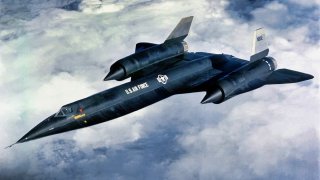YF-12: The Mach 3.2 Fighter Designed to Fight Russia in a War That Failed
Today, only one YF-12 prototype remains. You can see it at the Research and Development Gallery at the National Museum of the U.S. Air Force.
Meet the YF-12: When the Soviet Union’s MiG-25 “Foxbat” supersonic interceptor took to the skies during the Cold War, the U.S. realized that without certain aerial breakthroughs, it could soon be in trouble.
The Soviet airframe was designed to counter speedy American near-peers like the SR-71 Blackbird.
Both the Blackbird and the Foxbat could reach speeds of Mach-3.2, and the MiG-25 could also carry four air-to-air missiles. In order to compete and ultimately surpass the USSR’s aerial capabilities, the U.S. Air Force accelerated its efforts to develop an advanced long-range interceptor.
A Brief History of the YF-12
In the late 1950s, the winner of the Long Range Interceptor Experimental program was canceled by the Department of Defense.
Although the XF-108 Rapier could reach speeds of Mach-3.0, Lockheed Martin Skunk Works’ A-12 reconnaissance aircraft program for the Central Intelligence Agency was already underway.
The head of Skunk Works proposed to develop a specialized version of the A-12 called the YF-12. The Air Force eventually ordered three.
The YF-12 was essentially the twin-seat version of the A-12 and became the forerunner of the formidable Blackbird.
The major differences between the YF-12 and its predecessor involved the addition of the Hughes AN/ASG-18 fire-control radar and a second cockpit designed for a crew member to operate this radar for the air-to-air missile system.
A digital computer for navigation and firing was complemented by a second computer used for steering. Both were considered quite sophisticated at the time.
While only three YF-12 prototypes ever took to the skies, they set several records, including an altitude record of more than 80,000 feet and a speed record of roughly 2,070 miles per hour.
Later on, the Blackbird would surpass both these records, but the YF-12 still holds the marks for the heftiest, largest, and quickest manned interceptor to ever fly.
Two Pratt & Whitney J58 engines with 32,000 pounds of thrust each powered the YF-12. The airframe had a maximum speed of Mach-3.2 with a range of more than 2,000 miles.
The Usefulness of the YF-12
Despite the YF-12’s advanced capabilities, the program was cut short in the late 1960s due to its high cost, in addition to the ongoing war in Southeast Asia. One year after the airframes were relegated to storage, two of the airframes were recalled to be examined in a joint U.S. Air Force/NASA study of supercruise technology.

As detailed by NASA, “The YF-12's ability to sustain a cruise speed of greater than Mach-3 allowed NASA to expand its research capabilities. A large amount of flight research was performed in aerodynamics, propulsion, controls, structures, subsystems and other areas such as the physics of the upper atmosphere, noise tests and measurements, and handling qualities. The YF-12 flight research data was augmented by a series of wind tunnel tests, laboratory experiments, and analyses. As a result, the combined ground/flight research generated vast amounts of information that was later incorporated into the design of other supersonic aircraft. The program yielded over 125 technical reports.”
During the tests, which included in-flight heating and work on the Space Shuttle landing program, two of the airframes were damaged beyond repair. Today, only one YF-12 prototype remains. You can see it at the Research and Development Gallery at the National Museum of the U.S. Air Force.
About the Author
Maya Carlin is an analyst with the Center for Security Policy and a former Anna Sobol Levy Fellow at IDC Herzliya in Israel. She has by-lines in many publications, including The National Interest, Jerusalem Post, and Times of Israel. You can follow her on Twitter: @MayaCarlin.


